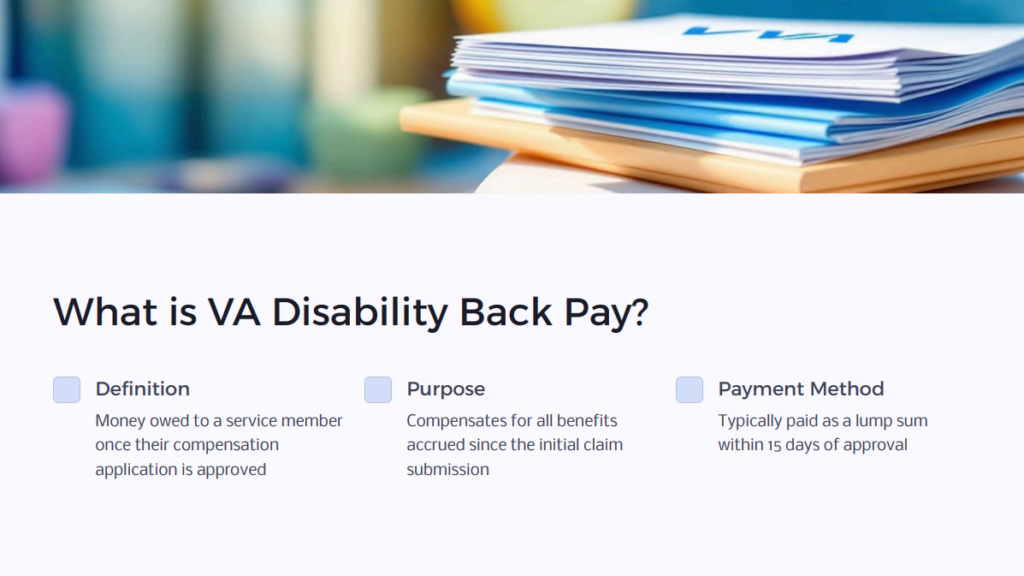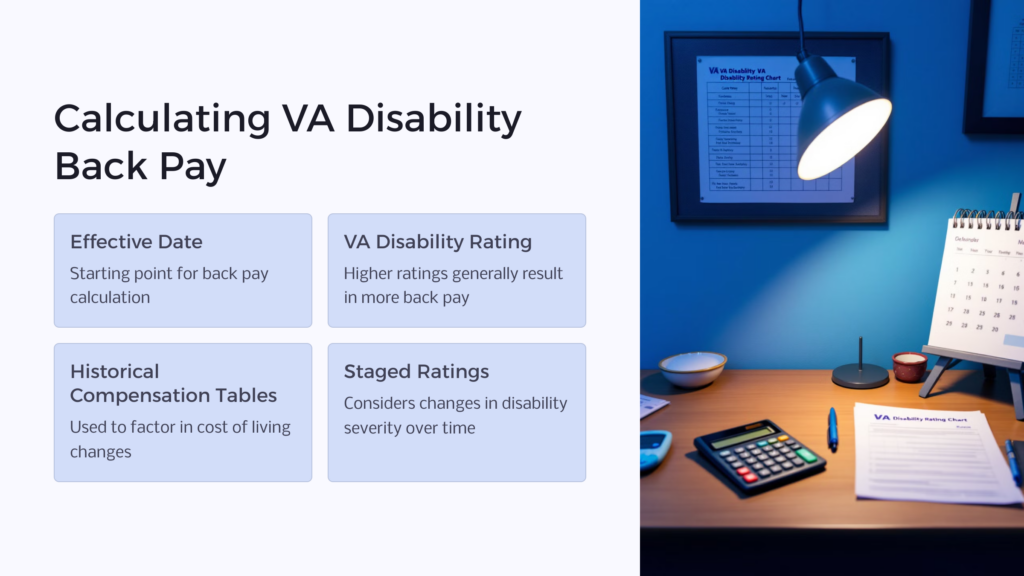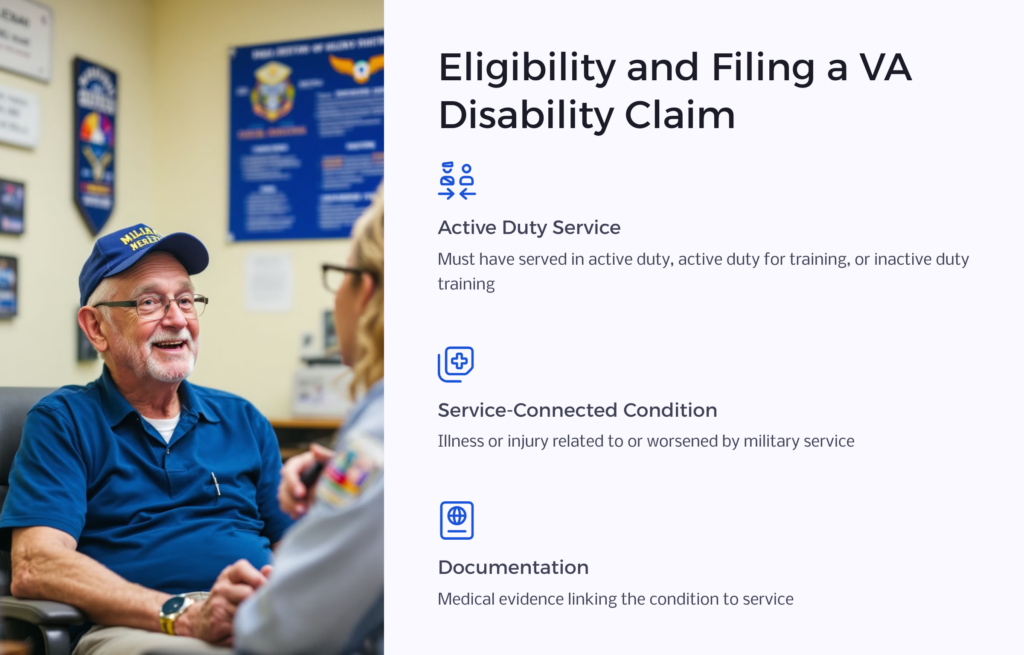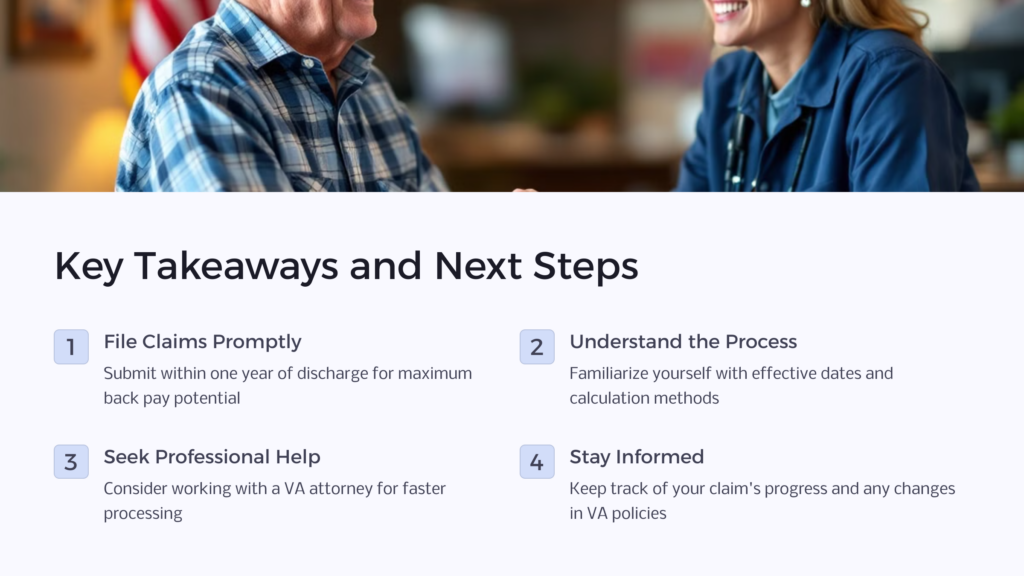Disability benefits from the U.S. Department of Veterans Affairs are tremendously important for the health and well-being of thousands of American veterans. However, the process involved in claiming your compensation can often be a long, laborious, and stressful journey for many. Part of that journey may include suffering through little to no income while you wait for your disability payments to be approved. Luckily, the VA is positioned to help compensate you for that through the allocation of VA disability back pay.
9 Common Questions About VA Disability Back Pay
- What is VA disability back pay?
- What is an effective date?
- VA disability timeline guide?
- How is VA disability back pay calculated?
- What are some common myths about VA disability back pay?
- Who can file a VA disability claim?
- Is my VA back pay taxable?
- Can a VA attorney help me get back pay faster?
- Is there a time limit for when I need to file my claim?
The process for being approved for veterans disability benefits can certainly be challenging. Since the VA faces such a substantial backlog of benefits applications, you can wait for months, sometimes even years, before your VA compensation claim is finally approved. But the good news is that once your claim is approved, the VA also will provide compensation for all disability benefits that have accrued while you’ve been waiting. Since VA disability benefits are designed to compensate veterans for considerable loss of working time, the VA will do its best to ensure it provides as much disability compensation as is appropriate, including back pay.
If you’re thinking about applying for VA disability benefits—or if you’re already involved in the compensation process—you may have questions about how back pay might apply to your case. Below are just a few of the most common questions associated with VA disability back pay.
What is VA Disability Back Pay?

VA disability back pay is any money owed to a service member once his or her compensation application is approved—the allocation of back pay allows the VA to compensate the veteran for all compensation that has accrued since the initial disability claim was submitted. Generally, the longer the VA takes to approve your disability claim, the more back pay it will owe you when you are approved. For some veterans, their resulting back pay ends up being a substantial amount.
Once your VA disability retroactive pay is calculated, you should receive it all in one lump sum (this is your VA disability back pay lump sum), while all future VA disability compensation will be paid in monthly payment installments. The VA makes a tremendous effort to ensure that any veteran approved for back pay receives it within 15 days of that decision, either through direct deposit or a paper check.
What Is an Effective Date?
Your effective date is the date the VA will use to determine when exactly your back pay should start. There are a couple of different ways that the VA can determine your effective date. It can use either the date on which you submitted your VA disability benefits claim, or if your condition developed a long time before, the VA can choose to grant you back pay all the way back to the onset of your medical condition or physical disability.
If you wait to apply for VA disability benefits until a year or more after you’ve already separated from military service, it’s highly unlikely that the VA will extend your back pay to the time of your injury or disability onset. And if you apply for your disability benefits within a year of military discharge, the VA generally will only pay back benefits from the time of your discharge date.
The effective date for a disability that was either directly caused or made worse by military service is typically aligned with the later of the following choices: the date the VA received your claim or the date of onset of the injury or medical condition. In most cases, if the VA believes, based on the information presented in your claim, that your disabling condition is related to your military service—this is known as presumptive service connection. The VA will consider your effective date as the date you received the injury or medical condition, as long as you apply for compensation within one year of being discharged.
There are some exceptions when the VA might use a different effective date from the two usual options. For example, there are requests for revision based on a “clear and unmistakable error” or requests from recently discharged service members who apply for VA disability benefits within a year of their discharge. If an inaccurate effective date were applied in an earlier review based on a mistake on the VA’s part, the VA will adjust the effective date to represent the effective date that would have been assigned if the error hadn’t taken place.
VA Disability Timeline Guide
The average benefit turnaround time is ~106 days from receipt to decision. So 3 ½ months is average, although several factors are at play here, including the complexity of your claim, the backlog at the VA, and any appeals or supplemental claims involved.
1. Initial Application: After submitting your initial application for VA disability benefits, it typically takes the VA several months to process and decide on your claim. The exact timeframe can vary but can take around 3 to 6 months on average.
2. Decision and Effective Date: Once the VA makes a decision on your claim, they will assign an effective date, which is the date from which you are eligible to receive benefits. The effective date is usually the date of your application or the date your disability began, whichever is later.
3. Notice of Disagreement/Appeals: If you disagree with the VA’s decision or the assigned disability rating, you can file a Notice of Disagreement (NOD) and initiate the appeals process. This can add significant time to the overall timeline, as appeals can take months or even years to complete, depending on the complexity of the case and the workload at the VA regional office.
4. Decision Review Officer (DRO) or Board of Veterans’ Appeals (BVA): If your appeal progresses to the DRO or the BVA, additional time will be required for the review process. This can vary greatly, but it typically takes several months to a year or more.
5. Grant of Benefits and Retroactive Backpay: Once your claim is approved or granted at any stage of the appeals process, the VA will determine the amount of backpay owed to you. Backpay is calculated from the effective date to the date of the grant or decision. It can take some time for the VA to process the payment and for you to receive the funds. Generally, receiving the retroactive payment can take several weeks to a few months.
Remember, these timelines are estimates, and individual cases can vary significantly. The VA continuously works to improve its claims processing times, but the backlog of claims and appeals can still lead to delays. Stay in touch with your VA representative/VSO for updates on your specific case.
How is VA Disability Back Pay Calculated?

Your VA disability back pay will be unique to you and your determined employability. There is no set amount a disabled veteran is entitled to receive. The VA will use several different factors when calculating your disability back pay. First is your effective date. The second is the specific VA disability rating assigned to your condition. In most cases, the higher the VA disability rating you receive, the more the VA will owe you in back payment. The VA also will consult its historical disability compensation tables, especially if it’s calculating back payments over multiple years. This allows the VA to effectively factor in the cost of living changes from year to year.
It’s important to note that many medical conditions and disabilities change over time, sometimes either improving or worsening. If this is the case, the VA may assign a staged disability rating to your condition, which allows the VA to consider how a disability changes over time as it evaluates your VA compensation claim. This sometimes can make the process of determining back pay a bit more difficult since it must be calculated relative to the severity of the condition from year to year.
What Are Some Common Myths About VA Disability Back Pay?
One common myth about VA disability back pay is that it always automatically goes back to the date of the original injury or onset of a disabling condition. That isn’t always the case. If you apply for VA benefits after you’ve separated from active service, the VA generally does not consider the date of an injury or disabling event as an effective date.
A second commonly held myth is that VA disability benefits always go back to the date of discharge, which also is incorrect. The VA typically only pays disability compensation going back to the date of discharge to veterans who apply for their VA disability benefits within one year of being discharged. All of this underscores the need to submit your VA disability benefits claim as soon as possible.
Who Can File a VA Disability Claim?

VA benefits are designed to help U.S. veterans who suffer disabilities that are either a direct result of or aggravated by active duty service in the U.S. military. The VA keeps a list of specific criteria an applicant must meet, including the following:
- You must have served in active duty, active duty for military training purposes or served while training in inactive duty
- In addition, you must meet at least one of the following:
- You became sick or injured during the time of service—not necessarily in combat or in the course of military duties
- You can show medical evidence that links your disabling condition with that sickness or injury
- You can show documentation of a medical condition that worsened during your time of service
- You can show documentation of a medical condition that is linked to your time of service but didn’t appear until after you had separated from service
If you meet these criteria, it’s a good idea to apply for VA disability compensation. If you are a U.S. military veteran who suffers from a condition or illness that may be considered as secondary to a disability incurred in service, you may also be eligible for VA disability pay.
Is My VA Back Pay Taxable?
VA disability benefits are a tax-free benefit to any U.S. disabled veteran. There is no income tax attached.
Can a VA Attorney Help Me Get Back Pay Faster?
Many applicants who work with a VA disability lawyer have found that they get good results. With a VA attorney, you may receive back pay faster than if you had completed the process on your own. Since a veterans disability lawyer is finely attuned to the specifics of VA disability law and is highly familiar with all the details of the application and appeals process, having that kind of knowledge and experience on your side can be very helpful.
Is There a Time Limit for When I Need to File My Claim?
Technically, no. You are welcome to file a VA claim any time before or after leaving active duty military service. But this is where an understanding of how the process works can help you. You’re likely to be able to collect a higher back payment amount if you file your claim within a year of leaving service. This is an important point that many claimants overlook, so don’t wait to file your claim. If you wait more than a year after separating from military service to file your VA claim, the chances of collecting back pay are dramatically reduced.
What About SSI’s Back Pay Release Deposits?
To ensure a smooth and timely release of your SSI back pay, it’s crucial to provide accurate and up-to-date information to the Social Security Administration (SSA). Once your SSI claim is approved, the SSA will determine the amount of back pay owed to you based on various factors, such as your application date and disability onset date.
Typically, the SSA releases SSI back pay in three equal installments. The first installment is generally paid within 60 days of approval, while the subsequent payments are released at six-month intervals. However, if the amount owed is large or if you have an urgent need for the funds, you can request an expedited payment schedule.
The deposit of your SSI back pay is typically made via direct deposit into your designated bank account. It’s crucial to ensure that the SSA has accurate banking information to avoid any delays in receiving your funds.
**If you don’t have a bank account, the SSA can provide you with a Direct Express debit card for depositing your SSI back pay.
Understanding Back Pay
While the VA is an organization that strives to meet the needs of America’s veteran population, it often finds itself buried under a backlog of VA disability benefits applications. That means it may take months, even years, for your VA disability claim to be approved. While you wait, you may accrue several months of back pay that the VA will owe you upon approval of your VA claim.
It’s important to understand how the process works and how back pay is calculated so that you can verify the accuracy of all decisions and rulings you receive during the process. Knowing the ins and outs of how back pay is determined can go a long way toward helping you advocate for yourself and ultimately be successful in getting the back pay you’re entitled to receive.

 Benefits.com Advisors
Benefits.com Advisors
With expertise spanning local, state, and federal benefit programs, our team is dedicated to guiding individuals towards the perfect program tailored to their unique circumstances.
Rise to the top with Peak Benefits!
Join our Peak Benefits Newsletter for the latest news, resources, and offers on all things government benefits.



















